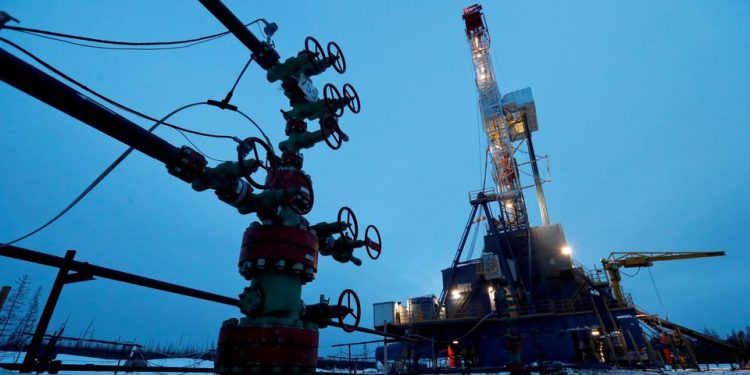Oil prices remained stable for a second consecutive day on Wednesday, supported by fears of disrupted supply due to the escalating conflict between Russia and Ukraine. Brent crude futures slightly dropped by 5 cents to $73.26 per barrel at 0541 GMT.
Meanwhile, U.S. West Texas Intermediate crude futures held steady at $69.39 per barrel. The market also found support from growing Chinese crude imports, which helped offset the increase in U.S. crude stockpiles. Despite concerns about rising inventories in the U.S., analysts note that China’s demand for oil continues to play a significant role in keeping prices stable.
Ukraine-Russia Conflict Remains a Key Factor
The ongoing war between Russia, a major oil producer, and Ukraine is a key factor in sustaining oil prices above the $70 mark. This week, the conflict escalated after Ukraine used U.S.-supplied ATACMS missiles to strike Russian territory, further raising geopolitical risks.
However, Russian President Vladimir Putin has also escalated the threat of a nuclear attack, signaling more severe potential risks. Analysts at ANZ warned that such developments bring back into focus the possibility of supply disruptions, which could lead to even higher oil prices.
Oil Prices Hold Steady Amid Rising Tensions in Ukraine and Increasing Chinese Demand
Oil prices remained largely unchanged on Wednesday, marking a second consecutive day of steady trading, as market participants weigh the geopolitical risks stemming from the ongoing Ukraine war and stronger-than-expected Chinese crude imports. While data showed an increase in U.S. crude inventories, the continued uncertainty in global markets due to tensions between Russia and Ukraine helped maintain support for prices.
Brent crude futures edged down 5 cents, reaching $73.26 per barrel by 0541 GMT. Similarly, U.S. West Texas Intermediate (WTI) crude futures held steady at $69.39 per barrel, showing little change despite the rise in U.S. stockpiles.
Ukraine War Continues to Impact Market Sentiment
The escalating conflict between Russia, one of the world’s largest oil producers, and Ukraine continues to be a driving factor in keeping oil prices above key thresholds.
Recently, the war took a dramatic turn as Ukraine launched U.S.-supplied ATACMS missiles into Russian territory.
Meanwhile, Moscow confirmed the attack, and tensions escalated further when Russian President Vladimir Putin hinted at a lower threshold for the use of nuclear weapons increasing global fears.
The intensification of the war has renewed fears of potential disruptions to oil supply, particularly from Russia, which has been a major exporter of crude.
Geopolitical instability in oil-producing regions often leads to market volatility, and investors are closely watching the situation, concerned that any further escalation could push prices higher due to potential supply shortages.
U.S. Stockpiles on the Rise
While the global supply picture remains uncertain, U.S. crude stockpiles increased, according to recent government data.
The rise in inventories was seen as a sign that domestic oil production is rebounding, although some analysts suggest that the increase may be temporary.
Despite the U.S. stockpile growth, the market remains focused on the broader international dynamics. Global supply disruptions, particularly from Russia, have kept a floor under oil prices.
As a result, analysts predict that oil prices may hold steady above the $70 level for the foreseeable future, as the market remains sensitive to developments in Ukraine and other geopolitical flashpoints.
Increased Nuclear Threat Heightens Risk Premium
The potential for a nuclear escalation, as warned by Russian President Vladimir Putin, has added to the uncertainty.
Analysts from ANZ noted that the growing risk of supply disruptions could intensify the upward pressure on oil prices.
Putin’s statements, which hint at the use of nuclear weapons in response to perceived threats, have placed the market on edge, further driving up the geopolitical risk premium attached to crude oil prices.
Market strategist Yeap Jun Rong from IG noted, “We may expect oil prices to stay supported above the $70 level for now, as market participants continue to monitor the geopolitical developments.” This reflects a broader sentiment among traders who remain cautious, keeping oil prices buoyant despite a rise in U.S. inventories and relatively stable global supply outside of the Russian conflict.
As the war between Russia and Ukraine rages on, and with global oil demand continuing to fluctuate, the oil market remains prone to volatility.
With both supply risks from Russia and increased demand from China in play, traders and analysts are bracing for continued fluctuations in the price of crude oil. If tensions in Ukraine escalate further, or if other major oil-producing nations face disruptions, oil prices could see significant upward pressure.
On the other hand, if U.S. production continues to rise and Chinese demand stabilizes, the market may find some relief. However, for now, the ongoing conflict in Ukraine and its potential to disrupt Russian oil exports remain the primary factors influencing the direction of the oil market.


















